Symptoms
Scroll for our full list of ways we can help you relieve your pain.
(253) 630-1575
Conditions
Treatment Areas
Below are just some of the many conditions we regularly treat for our patients. We invite you to learn more about how these conditions may respond to treatment.
If you have any questions, concerns, or would like to schedule an appointment, please contact us today. We look forward to providing you with the personal care you deserve.
At Lake Meridian Chiropractic, we specialize in very specifically and gently aligning the atlas (that’s the bone at the top of your spine, just under your head)
One study estimates over 50 million people in the US suffer from headaches, with approximately 30 million being affected by migraine headaches!
The term “whiplash” was originally coined to describe the manner in which a head is moved suddenly to produce a sprain in the neck.
An extremity is a limb or appendage of the body, particularly the hands and feet. If the weather is cold, you have to be sure to protect your extremities from frostbite by wearing gloves, warm socks, and boots. The noun extremity also means the outermost point or part — the one that’s farthest away.
Lower Back Pain
Chiropractic care has been shown by research to be the most effective treatment for chronic and acute low back pain. At Lake Meridian Chiropractic, we specialize in very specifically and gently aligning the atlas (that’s the bone at the top of your spine, just under your head) first; then the rest of the spine second.
How can adjusting a tiny 8-ounce bone at the top of your neck possibly help with the low back pain you’ve been having? When your atlas misaligns it throws your entire body off balance.
Here’s how: the bone shifts to the right or the left, causing your head to tilt (since your head is held up by the atlas). Instantaneously, and without you thinking about it, your body compensates to right your head, so that your eyes stay parallel to the horizon and your head is over your center of gravity. It looks like this:

As you can see, that tiny little bone at the top of your neck has far reaching effects; when it is out of place, the rest of the spine kinks and twists to maintain a more normal head position.
This can translate into low back pain, since the back curves to compensate for the misalignment in the neck, and more pressure is often placed on one side of the body than the other. This compensatory posture can be serious, and sometimes increase the likelihood of a disc bulge. In fact, when a disc in the low back is bulging, the best option to help eliminate the pressure in that area of the spine is to correct an atlas misalignment, to allow the entire spine to untwist, unwind, and come back into a balanced position.
If you are suffering from back pain schedule an appointment today for an evaluation of your atlas and its impact on your pain.
How can adjusting a tiny 8-ounce bone at the top of your neck possibly help with the low back pain you’ve been having? When your atlas misaligns it throws your entire body off balance.
Here’s how: the bone shifts to the right or the left, causing your head to tilt (since your head is held up by the atlas). Instantaneously, and without you thinking about it, your body compensates to right your head, so that your eyes stay parallel to the horizon and your head is over your center of gravity. It looks like this:

Upper Back Pain
While lower back pain seems to get all the attention, upper back pain is increasingly a problem, especially with more people spending time working at a computer, which often leads to bad posture if the computer is not ergonomically adjusted. Seeing someone hunched over a laptop is a common sight these days. It can also be caused by an acute trauma to the neck, such as whiplash from an auto accident. Chiropractic care can be a useful tool for this type of pain.
Also called thoracic back pain, upper back pain can either develop slowly over a few days or weeks, or may appear quickly as the result of an injury. You may first notice stiffness and aching between the shoulder blades or dull pain extending across your shoulders, which can become gradually more painful as time goes on. As the muscles and vertebrae of the upper back and neck are so closely connected, you may also feel neck pain and stiffness. This condition can make it difficult to move normally while doing daily tasks, and even make it difficult to sleep or roll over in bed.
Upper back pain may be caused by stress, tension and bad posture, or possibly may be related to arthritis, a disc injury or rib joint dysfunction. Both emotional stress, such as problems with job, finances or family, and physical stress due to a bad diet, lack of exercise or environmental pollutants, can contribute to this type of pain. As the thoracic part of the spine is designed primarily to create stability in the trunk, upper back pain is less commonly caused by degenerative disc diseases such as scoliosis, and is more usually due to muscle strain and tension causing pain and a slight dislocation of the vertebrae.
While anti-inflammatory medications or other pain relievers may be used to help relieve pain in the upper back, they do not address the underlying cause of the pain, which could lead to it becoming chronic. A chiropractor can treat the cause in a safe, comfortable way.
Your pain may be caused by a chiropractic subluxation, which is when one of your vertebrae becomes slightly out of alignment due to muscle tension or stress, putting pressure on a nerve. A chiropractic adjustment can realign your vertebrae, alleviating the pain. A certified chiropractor can treat the muscle strain and/or joint dysfunction that leads to upper back pain, and will work with you to develop an effective treatment strategy targeted to your specific needs, which may involve chiropractic adjustments and suggestions for changes in diet and exercise.
Neck Pain
Neck pain is a very common problem, as the cervical spine (the top part of the spine that supports our heavy head) is the most flexible part of the spinal column, with an ability to bend in multiple directions, which also makes it more vulnerable to injury. Neck pain can be either acute or chronic.
Acute neck pain is most often due to an accident or injury where the neck is suddenly whipped back and forth, causing whiplash. The sudden motion injures the ligaments and tissues that support the neck. Car accidents (especially being hit from the rear) are the most common cause of whiplash, however, whiplash can also be due to injury from such things as an intense rollercoaster ride, skiing accident or falling off a bicycle.

Chronic neck pain can be the result of either spinal degeneration or lifestyle. As we age it’s more common to acquire degenerative diseases such as cervical spondylosis, which is excessive wear and tear on the cartilage and bones in the neck. As we get older, the elasticity and thickness of the cartilage cushioning the vertebrae begins to break down, which can put pressure on the nerves. This can lead to pain, tingling or numbness in the affected area.
Neck pain can also be due to our modern more sedentary lifestyle, in which poor posture, a weak abdomen and obesity contribute to putting the spine out of balance. The spine’s supporting muscles work harder to try to keep the spine straight, leading to increased muscle tension and fatigue, and eventually neck pain.
Chiropractic care has been proven to be useful in treating neck pain. One study, published in The Annals of Internal Medicine, found that chiropractic treatment reduced neck pain more than medications such as ibuprofen, acetaminophen or even narcotics. After 12 weeks, 57% of the test group receiving chiropractic treatment reported a pain reduction of at least 75%, whereas only 33% of the medication-only group had the same response.
Another study in the Journal of Manipulative and Physiological Therapeutics found significant improvement in chronic neck pain from spinal manipulation, with improvements continuing up to 12 weeks post-treatment. The same effect was not found with massage therapy.
A chiropractic neck adjustment (cervical manipulation) can significantly improve range of motion in your neck, allowing you to move your head around pain-free. It also helps to relax your neck muscles, reducing tension and stiffness.
A qualified chiropractor can do a physical and neurological exam to determine the nature of your neck pain. They may also order additional tests, such as an x-ray, CAT scan or MRI to show possible fractures, bone spurs, bulging discs or herniations. They will then consult with you on a course of treatment that, in addition to in-office treatments, may include specialized exercises you can do yourself at home.

Neck Stiffness and Tightness
Ever feel like your neck stiffness and tightness just isn’t allowing your neck to move like it used to? There’s no pain there, but you wonder when things got so stiff. Did you know that often the cause of neck tightness and stiffness is a misalignment in the spine?
When the vertebrae in your cervical spine – which is a fancy way of describing the bones in your neck – are out of alignment, the muscles in your neck and shoulders tighten up and make you feel stiff. This is especially true for the atlas, the top bone in your spine, which sits at the top of your neck, under your skull. When this bone tips out of place, the rest of your neck automatically compensates to straighten your head. Because everything in the spine is connected – your head to your neck to your shoulders to your back – that stiffness can crop up at the base of your neck, or along the tops of the shoulders.
Adjusting the spine with focused attention on the atlas is often the best way to increase the range of motion in your neck. In fact, one of the most common side effects of seeing a chiropractor is better movement!
Just because you don’t feel any pain doesn’t mean you’re not out of alignment. If you’re beginning to feel like you’re not able to turn your head very far, or feel like things are tight or stiff in your upper body, call to schedule an appointment to get your neck checked. We’ll get your head on straight, and help you move more easily.
Headaches
One study estimates over 50 million people in the US suffer from headaches, with approximately 30 million being affected by migraine headaches!
Although most headaches do not indicate a life threatening illness, they are a major cause of pain, missed work and rank as one of the most common reasons people consult a doctor. With so many types of headaches (129 listed by the International Headache Society) it is hard to know where to go to get relief. Muscle tension headaches, cervicogenic (joints of the neck) headaches and migraines are three of the most common types of headaches and ones with which we have great success treating. Read some of our reviews.
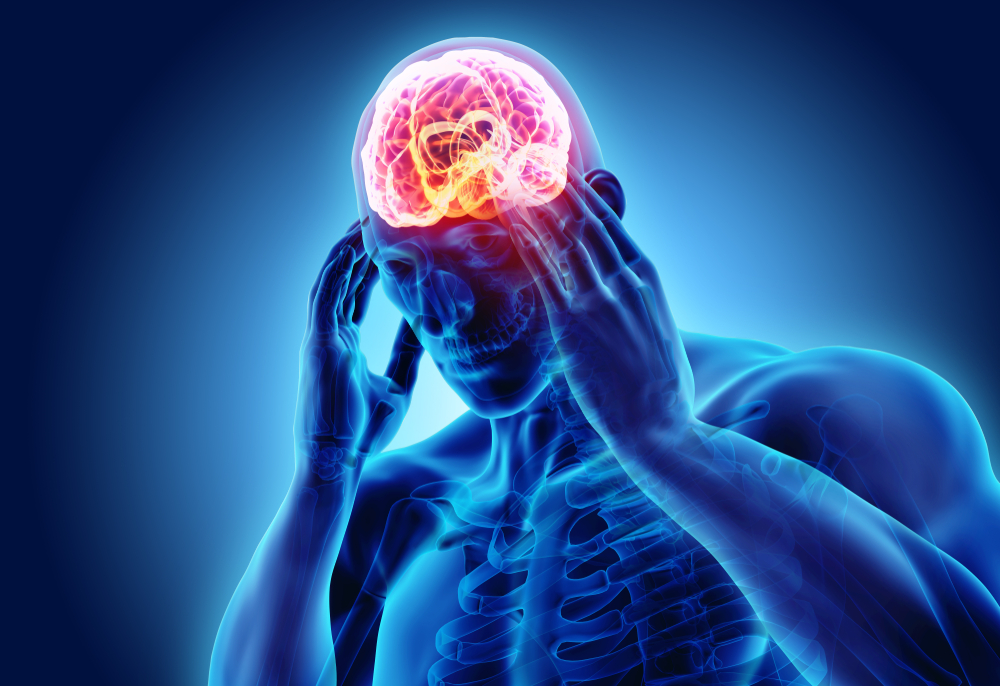
When we experience a stressful situation, one of the common ways our body responds is tensing the muscles, especially those in our neck and shoulders, which can then result in a “Stress (or Tension) Headache”. These muscular spasms and knots can pull your neck vertebrae out of alignment and if it is your atlas (the top bone of your spine) it can cause postural imbalances. Once out of alignment, the body can not self-correct the misaligned vertebrae but will continue to cause muscle tension as your body tries to right itself. This tension in turn irritates the nerves in this region sending a message to an area of the brainstem (trigeminocervical nucleus) resulting in more headaches and thus more pain, tension and muscle spasms.
The way we break this vicious cycle is to correct the cervical misalignments so that the body will come back into balance and thereby reduce the tension and pulling in the muscles and the resultant irritation to the nerves in this region. If you are suffering with headaches, schedule an appointment today to get on the road to feeling good again.

Migraine Headaches
A major cause of migraines or migraine headaches is a misalignment of the atlas vertebrae. When the atlas misaligns, a number of body processes are affected. First off, pressure is placed on the brain stem, which not only causes postural distortions and balance issues, but also pain in the area of the head and neck.
Secondly, the vertebral arteries, which wrap around the atlas bone, supply one third of your brain’s blood flow. During an atlas displacement, if even minute pressure is placed on these arteries, what you get is lack of proper blood supply to the brain. Specifically, these arteries supply most of the cranial nerves and the part of your brain responsible for vision, called the occipital cortex. When proper nutrition is cut off to this area of the brain (via reduced blood supply), what can result are floaters (little specks in your field of vision), light sensitivity, and sometimes the auras that accompany migraines.
By the use of mathematical calculations we can precisely realign the atlas vertebrae back into its correct position thus taking pressure off of both the brain stem and the vertebral arteries. This results in proper blood flow to your brain and proper nerve flow throughout the rest of your body. In restoring function to this ever-so-significant region of the spine, migraines are therefore reduced in both frequency and intensity, and oftentimes eradicated altogether.
Sciatica
Many people use the term sciatica incorrectly. Sciatica is pain along the path of the sciatic nerve which extends from the lower back down each leg. Sciatica is a symptom (like itching), it is not a diagnosis (like Parkinson’s disease). Sciatica can range from an occasional nuisance to excruciating pain that makes walking near impossible. There can be multiple underlying reasons for your sciatic nerve pain. A chiropractor can help find the root cause of the problem with an exam and may also order some diagnostic imaging such as an x-ray, MRI or CT scan to examine the underlying structures.
To answer the question, ‘what is sciatica’ it is helpful to explain some of the relevant anatomical structures. The sciatic nerve is both the longest and the widest nerve in your body. It begins in the lower back as five separate nerves that extend from five different vertebrae – L4, L5, S1, S2, and S3. These nerves meet up to form one large bundle which runs through the buttocks and down the entire length of the leg. The sciatica nerve is responsible (directly or indirectly) for nearly all the sensation in your leg including the skin of the thigh and gluts.
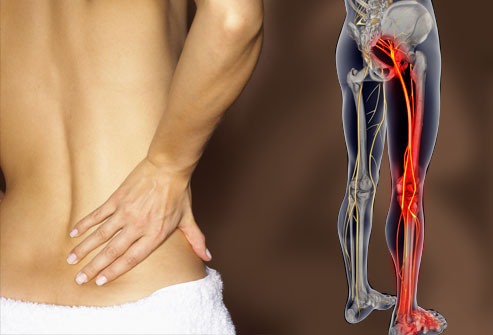
Sciatica occurs when there is compression or irritation of the sciatic nerve. The pain is felt in the low back and leg, but the site of the pain isn’t always the site of the underlying issue. Since the sciatica nerve is so long and travels around or through the large muscles of the buttocks, it takes an expert to determine if the pain is coming from disc compression, from muscle spasms or from something else. Again, sciatica is a symptom, not a diagnosis.
While sciatica is most often associated with pain, other symptoms may be present such as tingling, numbness, or muscle weakness. The pain can be nearly constant or intermittent. If you think you are experiencing sciatic nerve pain, keep a record of the location, duration and intensity of the pain. Your specific history plays an important role in determining the cause of the pain.
Treatment for sciatica depend on the underlying cause, so there is no one recommended course of treatment for all sciatic pain sufferers. Chiropractors use a variety of non-invasive approaches that include spinal manipulation, physical therapy, targeted stretching and active muscle release. They’ll also discuss the role that nutrition and hydration play in reducing tissue inflammation and keeping discs healthy. The spine, discs, muscles and soft tissue all have a role to play in sciatica and should be evaluated and treated as a connected system.
The most important thing to take away from this article is that sciatica (sciatic nerve pain) is a symptom of an underlying condition. You’ll only start to get better once the underlying condition is identified and this is done through a combination of an exam, history and recommended diagnostic imaging.
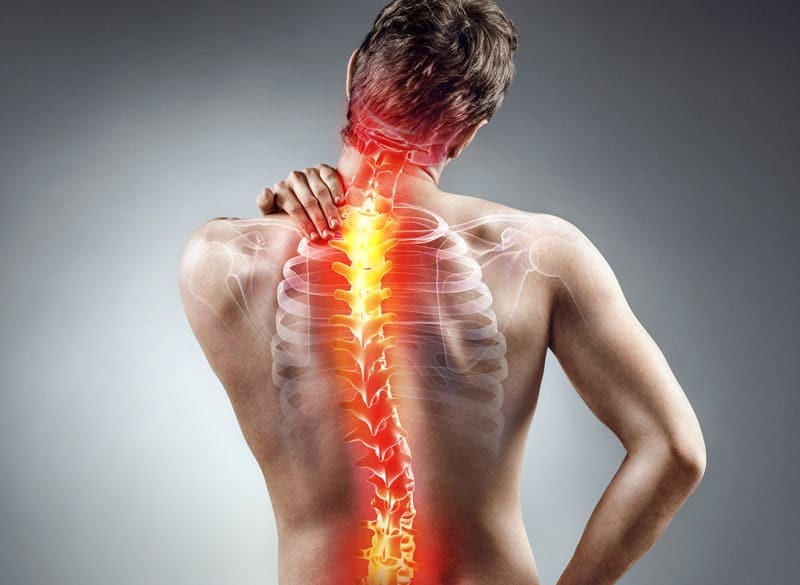
Scoliosis
Scoliosis is the development of abnormal curves side to side in the spine and unfortunately it often goes undetected, even with school screenings. Scoliosis usually develops in children between 8-18 years old because those are the rapid growth years. When it is finally discovered, there is usually some physical deformity that has developed such as an elevated shoulder or hip, humped back and/or head tilt.
What Causes Scoliosis?
The cause is not entirely clear, but recent research is shedding more light on the subject. We know uneven leg lengths and a tipped pelvis are associated. We know that uneven and prolonged muscle tension on one side of the spine will aggravate this condition. We also know genetics can be a factor, but not the only factor. Poor nutrition also plays a role because we see an increased incidence of scoliosis in kids who are malnourished and who consume more sugar and flour than others. A U.S. study on scoliosis patients found they consumed twice as much candy and soda as other children!
What can be done?
If you suspect your child has scoliosis call to schedule an appointment so we can do a scoliosis screening on them. We can adjust the atlas to bring the body back into balance and to even the leg length. When the body is in proper balance it also relaxes the muscle tension in the spine.
The main objective is to stop the progression of the curve. If it has not advanced too far, we can expect to see a reduction in the curves. One recent case of scoliosis in our office went from a 16 degree curve to completely straight with our treatment!
An annual checkup on your child is the best defense against scoliosis, so schedule one today.
Whiplash and Auto Accident Injuries
The term “whiplash” was originally coined to describe the manner in which a head is moved suddenly to produce a sprain in the neck. The more appropriate term used among doctors today is “whiplash syndrome,” which is a complex condition that is comprised of many injuries to the cervical spine.
So what is whiplash syndrome, and how is it treated? Simply worded, whiplash syndrome refers to the symptoms that occur following a whiplash injury. These can include physical symptoms like headaches, neck pain, and shoulder pain, as well as overall changes that can affect mood, like fatigue, anxiety, insomnia, forgetfulness, and lack of concentration.

Car collisions are a common source of whiplash injuries, but these conditions can occur in other ways. A blow to the head can cause the head and neck to move in such a way that whiplash syndrome can result. Falling down can cause a whiplash injury, whether from a slip on a slick floor or from a skiing accident, especially when the head quickly hits the floor or hard surface.
One kind of injury that is very prone to occur during motor vehicle collisions is ligament damage. Ligaments are the tissues that hold your bones together, including the bones in your neck (cervical spine). When your neck gets whipped to and fro (which happens so fast, most of the time you don’t know how dramatically it occurred), the ligaments in your neck get stretched and essentially aren’t able to do their job like they should: namely, making sure those neck bones (vertebrae) don’t slip and slide on one another.
Atlas Orthogonal Chiropractic has been scientifically proven to reduce whiplash syndrome and effectively aid in the body’s natural healing ability after a whiplash injury. In a study published in the peer-reviewed medical journal, Journal of Whiplash and related disorders, 221 patients diagnosed with whiplash syndrome were treated with Atlas Orthogonal Chiropractic care. After treatment, 84% of the patients experienced complete or near complete resolution of their pain and other neck related complications. All of the patients reported significant improvements in their conditions.
If you know anyone who has been in a car accident, or had a nasty fall while hitting the slopes, and is suffering from any of the symptoms we listed, let them know that help is out there for their whiplash injury. Schedule an appointment today to safely and effectively get out of pain and onto the road to natural healing.
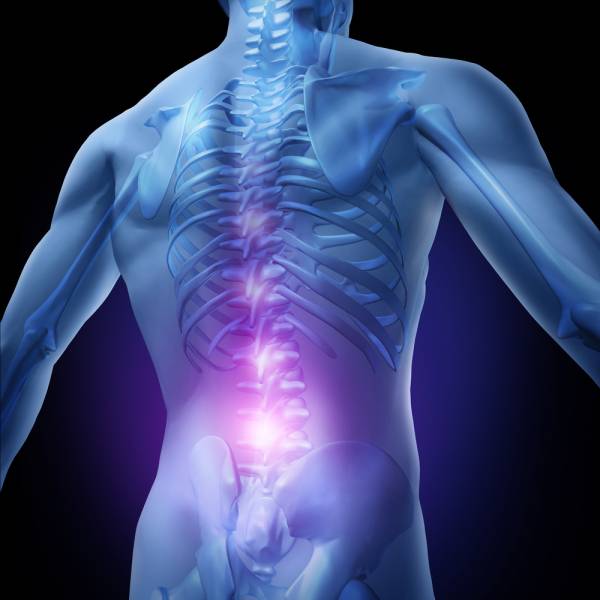
Disc Injury
Are you living with a slipped disc or other disc injury in Kent? If you have a suspicion that your chronic back pain is being caused by a disc injury, or you have received a diagnosis that confirms you are dealing with this kind of issue, you will probably benefit from the best chiropractic care in Kent you can find.
Whether the pain is mild or severe, it is important to deal with it promptly so that the issue does not progress and cause more permanent damage. Lake Meridian Chiropractic in Kent for disc injuries has a proven track record of providing both short-term pain relief and long-term recovery.
DISC INJURY TREATMENT IN KENT
The little pads that lie between your vertebrae are called the intervertebral discs. Each of these discs has a tough outer ring and a soft gel-like center. Your disc’s job is to both join and to separate your vertebrae from one another. These discs act as cushions, or shock absorbers, so that the bones don’t make contact with each other as you move around, carry large objects, and bend over. Here are a few of the different kinds of disc injuries that make movements difficult:
⦁ A protruding disc occurs when the disc becomes asymmetrical and the gel is pushed out or bulging.
⦁ A herniated disc is when the disc material has ruptured to the point that the gel pushes outward.
⦁ A disc extrusion is the worst type of disc injury. This is when the gel balloons extensively into the area outside the vertebrae or breaks off from the disc.
SIGNS AND SYMPTOMS OF A DISC INJURY
All of the above issues tend to result in considerable back pain, numbness, and limitation in range of motion due to the irritation of the nerve roots at the point where the injury occurs and the impact this has on the surrounding tissues. A number of distressing symptoms can arise from this nerve irritation and damage, including but not limited to:
⦁ Back pain
⦁ Neck pain
⦁ Weak legs or feet
⦁ Leg and foot pain, numbness and tingling (also known as sciatica)
Our chiropractic care in Kent for disc injuries has a proven track record to get the relief you desire.
Did you know that work-related injuries from a slip or fall while working, or are otherwise injured on the job, your medical expenses are covered by Labor and Industries whether or not you must miss work due to the accident? Did you also know that over 3 million people become injured each year while on the job?
There are a myriad of ways an on the job injury (OJI) can occur. For individuals who perform manual labor, the risk seems obvious; when you’re lifting heavy loads all day long, there’s more opportunity to strain something, to slip and fall, or otherwise injure your body. Some folks, though, don’t think about jobs where you sit all day long: like while driving a truck, or sitting at a computer desk all day. Doctors have known for a long time that repetitive motions or postures contribute to imbalances in the body, and these are many times the source of work-related injuries.

If your office chair and computer station are not set up ergonomically, or in a way that reduces stress on the body by allowing you to sit naturally in a neutral position, injuries that may result include carpal tunnel syndrome, elbow strain, tendonitis of the shoulder or elbow, low back pain, hip displacement, and neck pain. Even headaches can be caused by holding positions where your neck is straining, for instance, to see a computer screen. Some of this can be reduced in the ways you sit, but if pain is an issue, your employer should make necessary changes to the work station so that you’re sitting in a more neutral posture. If injury results from these repetitive postures, it is considered an OJI.
If you trip at work – let’s say on an extension cord that’s in a walk way – and strain your neck, or fall and injure your hip, the Department of Labor and Industries should cover the cost of treating the injuries you sustained. While lifting or carrying a heavy load at work, it’s common to strain the low back or the neck while twisting wrong or especially lifting objects above the head. This is why proper lifting techniques is so important in the work environment.
And who is the specialist who is the best trained to correct an on the job sprain or strain injury, especially in the neck or back? If you answered “my chiropractor,” you are correct. Whether your atlas (the top bone in your neck) misaligns while straining your neck to see the computer screen, or goes out after falling onto your hip on that slippery floor, we can correct the problem so that you’re feeling better and back at work in no time. Studies have shown for years now that employees injured on the job are back at work faster, with the least amount of future problems, after treating with a chiropractor as opposed to taking over-the-counter medications or seeing other health care practitioners.
If you or someone you know has sustained an OJI, don’t hesitate to give us a call. We’ll evaluate you and help you open a Labor and Industries claim so you can get back on track soon!

Sports Injuries
What do Lance Armstrong, Emmitt Smith, Michael Jordan, and the New York Yankees have in common? Besides being professional athletes, all of these people are under chiropractic care dealing with sports injuries.
For the human body to be able to throw a fast pitch, swing a tennis racket, punt a football, or pedal a bicycle, a series of events must occur for the motion to be smooth and effective. If any single link in the chain of events is weak, or any joint in the body involved in the necessary motion is misaligned or not functioning properly, problems can occur. One problem is that when one part of the body isn’t performing at its best – like the shoulder joint during a pitch – the brain gets other pieces of the puzzle to compensate for the lack of power, to fill in for the “weak link.” So if a pitcher’s shoulder joint is functioning less than optimally, he then compensates by throwing harder, causing a break in proper form, poor performance, and potential injury.
Chiropractors treat all the joints in the body to ensure that there are no misalignments. By getting the spine and other joints checked by a chiropractor, and getting adjusted as necessary, the parts move like they are supposed to, and the athlete – whether pro or amateur – can function at his/her optimum level of power and performance.
John Stockton, former professional basketball player who spent his entire career as a point guard for the Utah Jazz and Hall of Famer, attributes his longevity in the game to good chiropractic care. Says John, “It’s not just adjustments, it’s balancing muscles and overall health.” As Stockton points out, for the body to be able to function at its best, it also has to be balanced. When the atlas goes out of alignment, muscles down the entire spine and the rest of the body do not contract equally. This stresses the body unnecessarily, so that when you try and play sports while imbalanced, injury can occur much more easily.
To demonstrate this, pick up a moderately heavy weight that you are able to lift, such as a full backpack or briefcase. Gently lift the object directly above your head. Standing there with a weight over your head is hard enough, but now try shifting the weight about 4 or 5 inches to the left. After several seconds, you will notice that maintaining a proper posture becomes more difficult, and the weight itself will start to feel heavier than it was when it was directly above your head, in a balanced position. When your atlas is in proper alignment, it is able to easily handle the weight of your head – just like when you had a weight centered above you. When the atlas shifts out of position, trying to maintain balance in the body becomes more and more difficult – like when you shifted the weight to one side, and began struggling with it.
Having your atlas in alignment along with the rest of the spine can not only help you function at your maximum level of performance, but also help prevent possible injury.
Concussions (MTBI)
If you have kids or know someone who does…please read this
The study and treatment of concussions is very personal one to me because when my son was in 3rd grade he got a concussion after falling in recess and cracking his head on concrete. The interesting thing I noticed right away is this normally very articulate kid wasn’t making sense. His talk was garbled, and even he said “this isn’t like me, normally I can remember things.” This voracious reader was struggling to read—it was very labored, he made mistakes and it was very straining for him. Even his speech was a little bit slower. All of these symptoms are common and known to happen after a concussion.

What isn’t known is what I discovered next. I took atlas x-rays on him and was mortified to see the worst tipped atlas I’d ever seen in a child—12 millimeters. You can have pressure on your brainstem with just 1 mm discrepancy and he had 12! What made it worse was the severe kink between his neck and head.
The good news is we adjusted him and got the atlas level, his head is on straight and he has recovered 100%. Since that time we’ve successfully treated kids of all ages with post-concussion syndromes. The bad news is, how many kids out there have fallen and hit their heads or had a head injury and have no idea they need their atlas checked? Who is going to tell them? This also got me wondering how many kids might be struggling with reading, focus or learning in school that could be traced back to some fall or hit to the head that messed up their atlas or cranial plates and was never treated.
If you know someone that should be checked PLEASE, for their sakes, schedule an evaluation today.

Elbow Pain
Tennis elbow usually refers to pain in the outer part of the elbow and the upper part of the forearm. This pain is caused by inflammation of the tendon when it rubs against the bony protuberance at the outer part of the elbow. Chiropractic care helps to realign the entire body, especially the bones that comprise the elbow joint, and reduce pressure on the involved ligaments.
Despite the name, “tennis elbow”, only about five percent of tennis elbow patients actually play racquet sports. Your doctor may also call it a tendonitis of the elbow or lateral epicondylitis. Whatever name is used, the pain is a result of overuse caused by repetitive movements of the wrist such as gardening, keyboarding, mousing, etc. The most common symptoms of tennis elbow include pain over the outside elbow, which can also radiate up or down the arm, wrist weakness, tenderness over the outside of the elbow, and difficulty extending the forearm. Pain when lifting or bending the arm may also be a sign of a ligament problem, along with pain when gripping or carrying an object.
The great news is we love to help people who have tennis elbow symptoms because it responds so quickly to our treatment. We examine and treat any area relating to the function of the elbow and muscles of the forearm, such as the wrist, shoulder and neck and the relief they feel is tremendous.
If you suffer with elbow pain that doesn’t resolve after a couple days of ice and rest, then call to schedule an appointment and start feeling better.
Knee Pain
Knee pain is one of the most common orthopedic ailments treated by chiropractors. The knee takes a huge amount of stress, as it is built only to bend in one direction; however, many movements we make force the knee to bend slightly in other directions, along with having to support the weight of the body, which can lead to knee pain and injury. It is quite easy to damage the tendons, ligaments, meniscus (knee cartilage) and bones that comprise the knee, and this damage can take months to recover from.
Having chronic knee pain can seriously interfere with your life, making it difficult to do the simplest everyday things such as walking up and down stairs, grocery shopping or even just walking across the room. Knee pain can be chronic (i.e. stemming from osteoarthritis, degenerative joint disease, etc.) or acute (i.e. stemming from an accident, sports injury, etc.) Whether due to previous injury, increased body weight or just living longer, degenerative knee pain and is a condition that is becoming much more common in people over age 50, and the chronic pain, swelling and inflammation can put you at higher risk of arthritis.
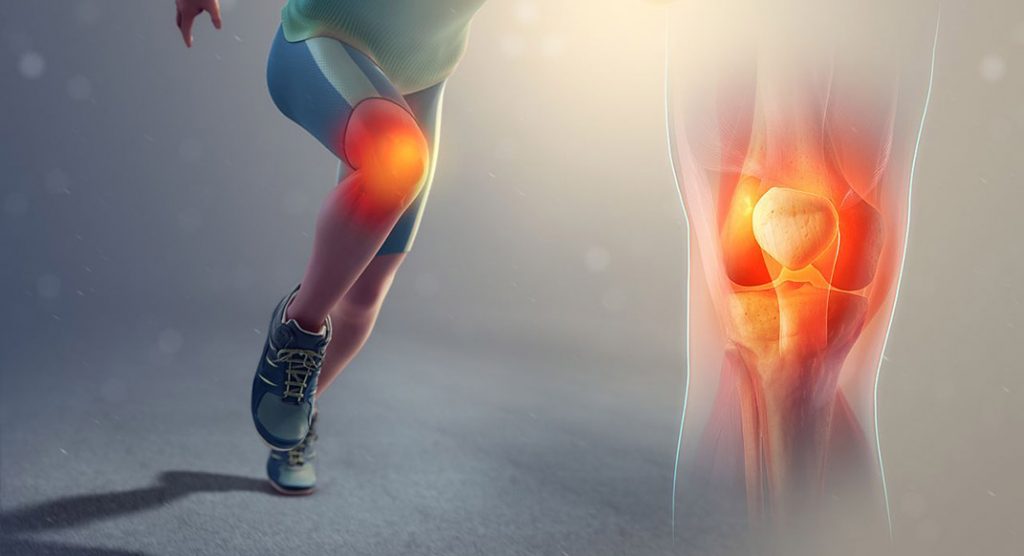
Hyperpronation (putting most of your weight on the outsides of your feet as you walk) can be a cause of knee pain. You may be able to determine if you are hyperpronating by examining the heels of your shoes. If they are excessively worn on the outsides, this is likely due to hyperpronation, and you may want to look into getting special foot supports to correct this problem.
While injury to the knee itself is quite common, some people are not aware of the fact that sometimes the pain in their knee may not be due to a knee injury, but is actually referred pain from an irritated nerve in the lower back area of the spinal column. Many with pain in their knees report also having pain in their lower back and pelvis, which may be due to inflammation around the nerves connecting the knee to the spinal cord.
While pain medication or cortisone shots may provide temporary pain relief, they do not address the root cause of the problem, and long-term use of either of these medications is not recommended. However, a qualified chiropractor can evaluate your condition and provide safe, holistic treatment that doesn’t involve the use of drugs or surgery.
Chiropractic treatment may involve spinal adjustments, joint manipulation, stretches, exercises and advice on footwear or orthotics that will address the cause of your knee pain and start you on the road to healing.

Carpal Tunnel Syndrome
Carpal tunnel syndrome is pressure on the median nerve — the nerve in the wrist that supplies feeling and movement to parts of the hand. It can lead to numbness, tingling, weakness, or muscle damage in the hand and fingers. The area in your wrist where the nerve enters the hand is called the carpal tunnel. This tunnel is normally narrow, so any swelling can pinch the nerve and cause pain, numbness, tingling or weakness. This is called carpal tunnel syndrome. Carpal tunnel syndrome is common in people who perform repetitive motions of the hand and wrist. Typing on a computer keyboard is probably the most common cause of carpal tunnel.
One major way a chiropractor can relieve the pain of carpal tunnel syndrome is by checking the carpals, or wrist bones, for misalignments. There are eight carpal bones, and when any of them are out of place or not gliding as they should, pressure on the median nerve can result, as the carpal tunnel is compressed and decreases in size. Often, a simple adjustment can relieve the pressure from this nerve.
Sometimes, more than one bone or structure is involved and further treatment is required, such as with a triple crush syndrome. This is where the nerve is being compressed in more then one spot along its path as it exits the neck, travels past the elbow and passes through the wrist. We often see that this is the case on patients whose carpal tunnel syndrome hasn’t responded to carpal tunnel surgery.
Additionally, treatment may be needed to reduce the inflammation that can result in carpal tunnel syndrome. Inflammation is a primary cause of pain in our bodies and cold low level laser therapy is an excellent way to heal tissues on a cellular level.
Shoulder Pain
Shoulder pain is a common complaint that patients present with to both primary care physicians and chiropractic practitioners. There are several underlying conditions that may cause discomfort in this area, many of which may be assisted by chiropractic treatment and manipulation. A proper diagnosis is important in order to determine what kind of treatment is indicated in each case.
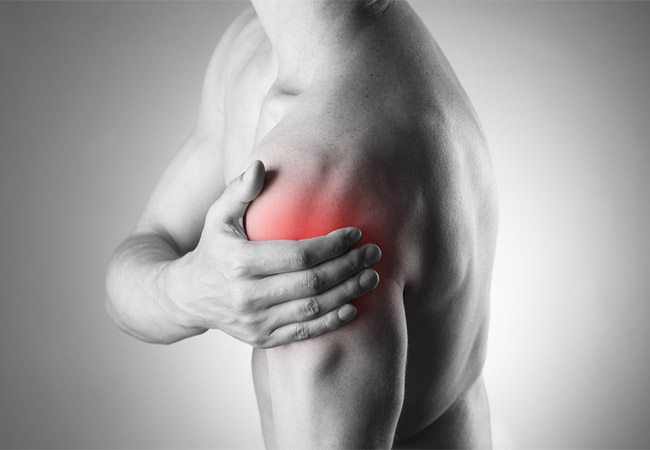
Commonly observed causes of shoulder pain include:
- Bursitis or tendinitis of the rotator cuff (inflammation of the shoulder joint, also called impingement syndrome, since the inflammation impinges on the ability of the shoulder to move fully)
- Frozen shoulder (restriction of joint movement by the shoulder capsule, also known as adhesive capsulitis)
- Rotator cuff tear (tearing of the shoulder tendons away from the bone). The rotator cuff refers to the group of four muscles and tendons that are responsible for moving the shoulder joint
- Shoulder dislocation and shoulder instability (repeated dislocation, which may follow the initial occurrence as a result of the weakening and tearing of shoulder ligaments)
- Synovitis (inflammation of the synovium that protects joint bones from rubbing together)
- Calcific tendinitis (calcium deposits in the shoulder tendons)
- Referred pain from the neck or elsewhere in the body
- Arthritis (wearing away of shoulder cartilage)
- Fractures
The precise nature of chiropractic treatment for shoulder pain depends on which of the above diagnoses is made by your practitioner, but will likely include some degree of manipulation to ensure correct spinal alignment (especially in the neck) and improved shoulder mobility and function. Additional measures such as heat and ice packs, stretching and strengthening exercises, anti-inflammatory medication, rest and cortisone injections may also be discussed. Furthermore, your chiropractor will want to look at your overall health, diet and lifestyle to see if any improvements can be made to assist with your healing process. Signs that you should consult a chiropractor about your shoulder include the following:
- Pain when carrying objects
- Shoulder pain at night and when resting
- Being unable to raise your arm
- Pain that persists beyond a few days and is unimproved by rest and painkillers
- Warmth, redness and/or swelling of the shoulder and/or fever, which may indicate infection
- Bruising around the shoulder area
Chiropractors are specialist health care professionals who deal with shoulder pain on a daily basis.
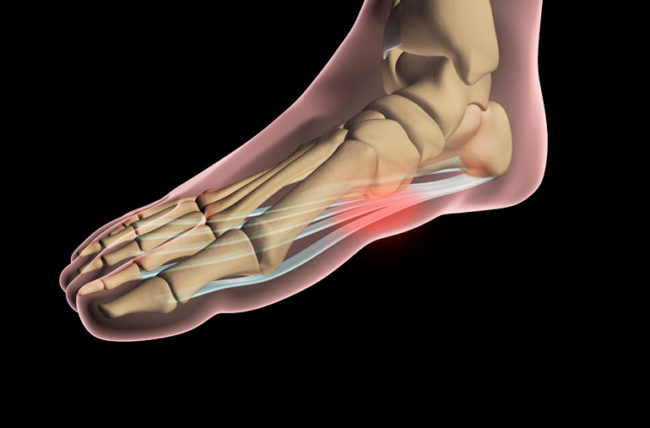
Plantar Fasciitis
Plantar fasciitis (pronounced “plan-tar fash-ee-EYE-tis), also sometimes known as a heel spur, can be a debilitating condition that makes walking even a short distance a painful prospect. The pain, ranging from mild to severe, is centered around the bottom of the heel, usually toward the front, though it may also extend across the entire bottom of the foot. It is most often noticeable first thing in the morning when you get out of bed and walk a few steps, or when you stand up after sitting for a length of time.
Healing usually takes time. However, there are some things you can do to help ease the pain and speed the healing process. These include making a visit to your chiropractor.
There are a number of causes that contribute to plantar fasciitis, the main ones being:
- Standing for long periods of time
- Wearing shoes with little support
- Having flat feet
- Having exceptionally high arches
- Being overweight
- A sudden increase in activity
- Repetitive stress
- Tight calf muscles
- Overpronation (walking on the outsides of your feet)
- Aging
The plantar fascia extends from the heel bone to the base of the toes, and when it becomes inflamed due to one of the above conditions, pain and bone spurs can result. The muscles in the foot may also be involved, especially if the pain occurs after long periods of standing or from chronic overwork, which causes the muscles to shorten, making them less resilient and liable to tear.
There are a few things you can do yourself at home. The first thing is to rest the foot as much as possible. Applying ice to the area can help reduce the inflammation, as can taking an anti-inflammatory such as ibuprofen. Many people with plantar fasciitis find it helpful to wear Birkenstocks or other shoes that have good arch support. In the long-term, however, you’ll want to address the cause of the problem, and your chiropractor can help in that regard.
Qualified chiropractors are experts at treating musculoskeletal problems. To treat plantar fasciitis your chiropractor may utilize a range of therapies, including manipulation, stretching, ultrasound and soft tissue work. They can also recommend orthotics and useful exercises you can do at home to gently stretch tight muscles and tendons. Since one common cause of plantar fasciitis is overpronation, a series of chiropractic adjustments can ensure your bones are properly aligned, allowing for greater range of motion and helping to take some of the strain off the overworked muscles in your feet.
Healing plantar fasciitis is a slow process that may take weeks or months, but with good chiropractic care and proper shoes, it does not have to become a chronic condition.
TMJ – Tempromandibular Joint Disorder
TMJ stands for Tempromandibular Joint Disorder. It is a common condition in which there is limited range of motion within the jaw. The jaw is a hinge joint that is connected to the skull through 68 muscle pairs located in front of the ears. These muscle pairs are important to speaking, chewing, swallowing, and yawning, and are among the most commonly used in our body.
There is a disk in the jaw known as the articular disk, which separates the skull from the condyle head of the mandible. Misalignment of this disk can cause TMJ. This misalignment may be caused by stress, which causes clenching and grinding of the teeth, sometimes during sleep. TMJ can also be caused by missing or crowded teeth, or trauma including whiplash. Up to 35% of Americans suffer some form of TMJ.
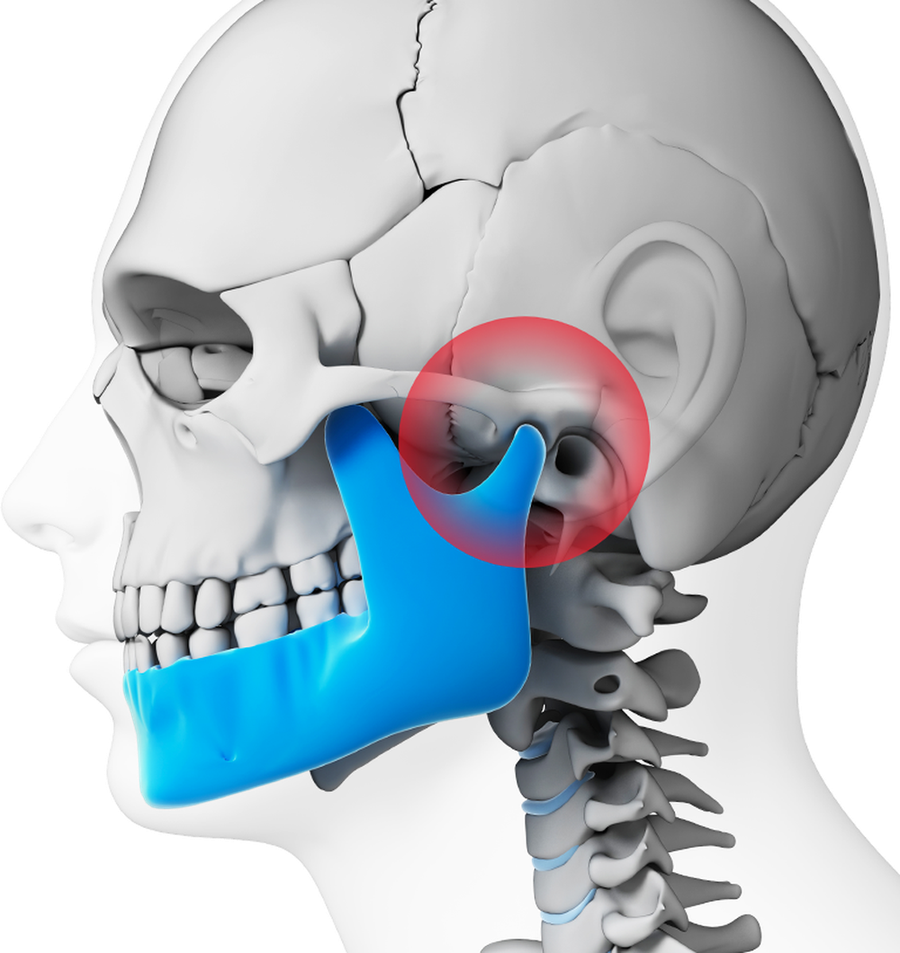
Symptoms of TMJ include pain and stiffness upon opening or closing the mouth, or a cracking, grinding or popping sound when using the joint. The condition creates significant wear on the joint and can have serious consequences for normal daily use of your jaw.
As chiropractors are experts in joint misalignment, they are well suited to treat TMJ. Your chiropractor will look at all aspects of your lifestyle and will ask you for a complete medical history. X-rays are useful to locate the condyle head of the mandible and check the positioning of the articular disk. Palpating the area also helps to establish the severity of the condition.
Treatment focuses on relieving tension in the many muscles of the jaw and possibly the neck and upper back. It will exclude surgery and medication, and may include adjustments and manipulation of trigger points by hand to achieve relaxation. If stress is one of the causes of your TMJ, certain exercises and relaxation techniques can be very useful to relieving the symptoms. These techniques might include meditation, massage, counseling and biofeedback. Heat and ice can also be soothing. You may also be asked to do some exercises at home.
The result of these treatments is usually greater range of motion in the jaw joint, which not only relieves jaw pain but the locking and popping, headaches, and neck pain. However, chiropractic care goes beyond pain relief and is often able to prevent TMJ from returning. The combination of effective treatment options and the avoidance of medications or surgery make chiropractic care an excellent choice for treatment of TMJ.
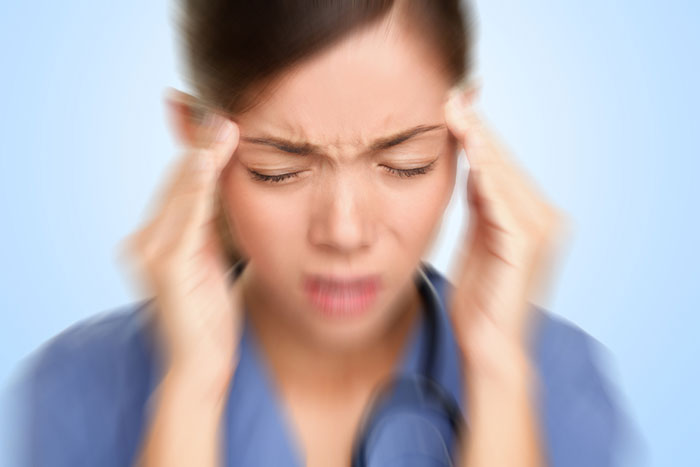
Dizziness & Vertigo
It is extremely difficult to function normally when dizziness or vertigo hits. You may feel your head spinning, the room spinning or unable to see straight… and then, the nausea sets in. Specific upper cervical treatment has alleviated these symptoms in our patients.
Your atlas, or C1 vertebra, is located at the top of the spine, just under the skull. This tiny bone has two very important arteries wrapping around it, on their way to supply blood to the brain. When the atlas is misaligned, pressure on these arteries can result in lack of blood to the brain, not to mention throw your whole body off balance as your core tries to make up for your crooked head and neck! Pressure on the brainstem also occurs from an atlas misalignment. The combination of undue stress on the nervous system and reduced blood flow to the brain can create a host of symptoms, dizziness and vertigo being common examples.
One research study looked at 60 cases of chronic vertigo, and results showed that 100% of cases either improved or completely reversed their condition with specific chiropractic adjustments. Fifty-six of the patients recalled a history of trauma, but all of them had a neck imbalance, which was treated by precise upper cervical correction like Atlas Orthogonal Chiropractic. All participants had been diagnosed by their physicians with various forms of vertigo, including Meniere’s, positional vertigo and migraine associated vertigo.
If you’d like to have your atlas evaluated to see if it is causing your symptoms call for an appointment today.
Allergies
When most of us sneeze, we put it down to a cold or even allergies, and our first thoughts are to pop an antihistamine pill – not to call a chiropractor! But did you know that a chiropractor could help you overcome your allergy problems? Most people associate chiropractors with back and neck issues, and while it’s true that chiropractors can help with such health conditions, they can also help the body achieve optimum health by ensuring the spine is correctly aligned.
A study from the University of California found that signals from the nervous system may influence the function of the immune system. While our immune system is there to fight against viruses, disease and infection, and helps to keep the body performing at its peak, it also works to dispel foreign contaminants that enter the body. When we sneeze because of an allergy, it’s because our body detects the presence of a foreign object in the system, such as dust, mites, pollen, etc. and it produces chemicals to neutralize and expel the allergens. These chemicals are known as histamines. In the case of allergies, the immune system overreacts to the presence of the allergens in the body.

A chiropractor may help by removing the nerve interference from compressions in the spine. As a result the immune system is able to function optimally once more.
Most traditional treatments for allergies, such as antihistamines, only deal with managing the symptoms and don’t eliminate the cause. The safety of anti-allergy medication is under debate, the long-term use of antihistamines or combined with other medication may cause cancer. A study conducted in lab rats with brand name anti-allergy medication found that cancerous tumors in the rats grew much father with the intake of antihistamines.
A chiropractor treats the patient by releasing the stresses on the patient’s nervous system, which as a result causes the immune system to work more effectively and as a consequence allergies are thereby reduced. Patients with misaligned spinal vertebra may have pinched nerves, which apply pressure and stress the system. Once the trapped nerve is released, the nervous system in general is free from stress and the body can then work more effectively to neutralize the allergy-causing chemicals found in the body.
Spinal health is as beneficial to the body as is good nutrition. A chiropractor can help the body to achieve optimal health and can help to improve the quality of life.
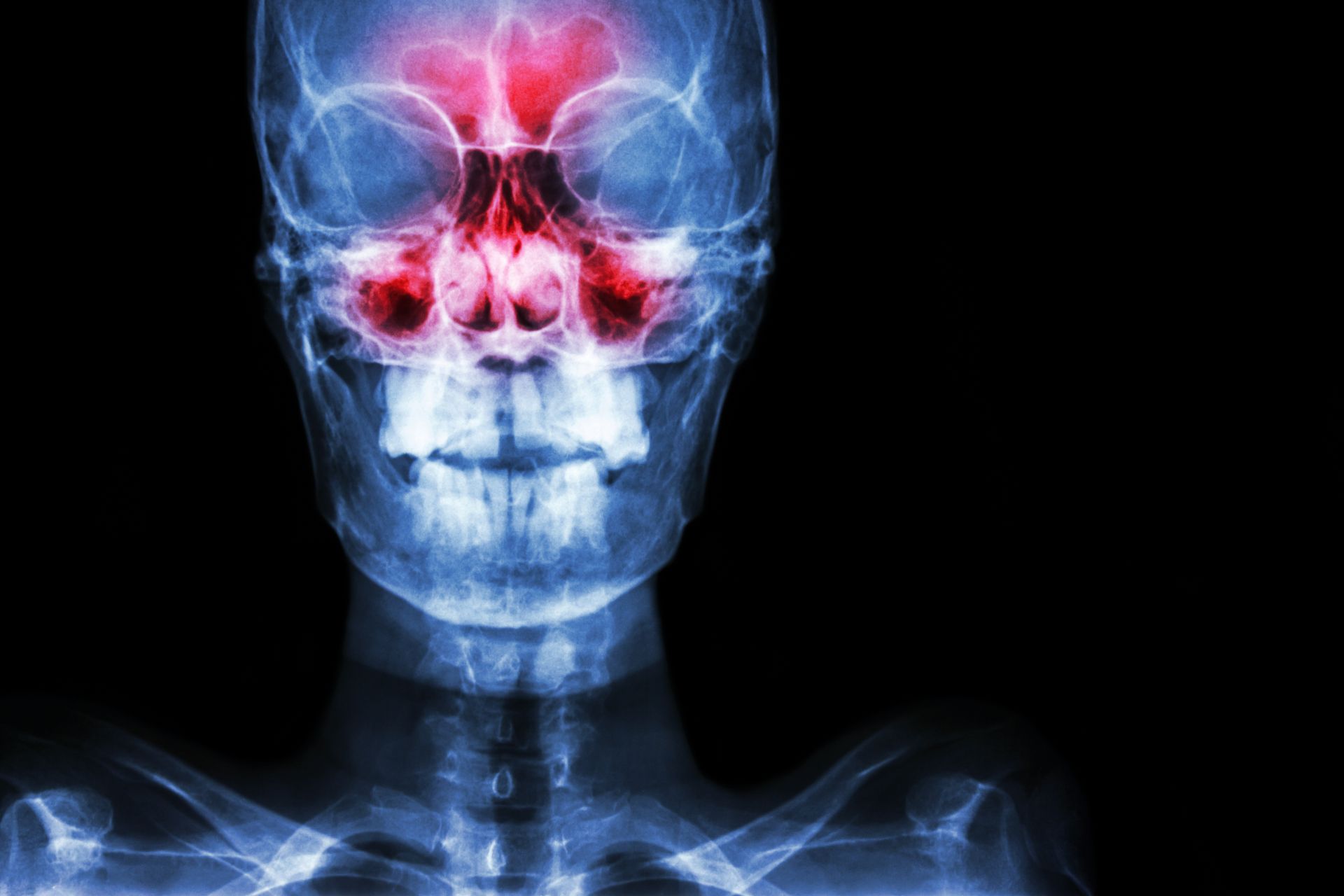
Sinuses
Who amongst us hasn’t experienced sinus pressure or clogged sinuses in his/her lifetime? Sinuses are simply hollows within the bones of our skulls lined with mucus membrane, and there are a few in particular that can be affected with allergies and illnesses such as cold or flu viruses. What you may not know is that we at Lake Meridian Chiropractic can effectively reduce sinus pressure and discomfort with chiropractic treatment.
Adjusting the atlas has an impact on sinus health and how well they are able to drain, be it from overactive mucus membranes due to allergies or due to sick bugs. There’s a lot to say about how your immune system is benefitted with chiropractic care, but that’s another story. In addition to the alignment of your atlas, there are special ways to boost the immune system to help your body fight off bacterial and viral infections. We can also help with sinus drainage relating to seasonal allergies. The symptoms you get from allergies result from an overactive immune system. Helping to balance the immune system with chiropractic care is just another way we can keep you healthy and feeling great year-round!
Fibromyalgia
Fibromyalgia is a condition with no known medical cure. It is characterized by chronic and debilitating pain all over the body, and heightened pain under pressure. Its symptoms can cause patients to suffer from widespread pain, poor sleep, chronic tiredness and even depression. The causes of fibromyalgia are unknown. Some theories cite that the patient’s low pain threshold may be attributed to increased sensitivity in the brain to pain signals. Other possible causes could be a genetic predisposition, stress, the disruption of normal dopamine related neurotransmission, abnormal serotonin levels and deficient growth hormone secretion. While there is currently no cure for the condition, its symptoms can be alleviated by chiropractic treatment.
Chiropractic treatment uses manipulation, which is a technique involving short and quick thrusts to the vertebrae in the spine to shift vertebrae back into their correct position. The treatment found in chiropractic care is based on the idea that illnesses and pain in the body arise from misalignments in the body’s skeletal structure. In order for the body to function healthily, the spine and the skeletal structure need to be set in the correct position – otherwise problems like chronic pain can arise.

Fibromyalgia causes numerous, tender points to occur all over the body, including back and neck pain and leg cramps. As a result of these symptoms, sufferers of fibromyalgia have sought treatment from chiropractors. Because the adjustments made during treatment help to restore the posture of the skeletal system, many sufferers find that treatment can help to reduce a significant amount of pain. Some fibromyalgia sufferers experience a condition known as cervical spinal stenosis, which results in compression of the spine’s meninges, which are the coverings of the upper spine. This can result in debilitating pain all over the body. A chiropractor may be able to help with cervical spinal stenosis by adjusting the spine around the head and neck, releasing this compression and eliminating the symptoms attributed to it.
The effectiveness of chiropractic care has been studied in sufferers of fibromyalgia, where patients were asked which method of treatment, medical or alternative, helped the best with their condition. The majority voted for chiropractic treatment. In addition, the effectiveness was tested by using spinal manipulation to relieve fibromyalgia symptoms, and after 15 treatments, results concluded that patients had reduced fatigue and pain as well as improved sleep quality.
While fibromyalgia sufferers continue to look for a cure, it is great to know that there are ways to alleviate the symptoms and live a more normal life. If you or someone you know suffers from undiagnosed chronic pain or fibromyalgia, please share this article with them and encourage them to get a chiropractic consultation.

Pregnancy Discomfort
lf you are pregnant and suffering from low back pain, a neighbor or a friend has probably suggested you visit a chiropractor because a chiropractor a. was able to help them during their pregnancy. The discussion probably left you curious, is that good advice or just a single success story? Additionally, you may be wondering whether chiropractic is safe during pregnancy and how much low back pain improvement the average pregnant woman can expect to get. After looking at several scientific publications on these exact topics, the appropriate conclusion seems to be that “chiropractic evaluation and treatment during pregnancy may be considered a safe and effective means of treating common musculoskeletal symptoms that affect pregnant patients. The scarcity of published literature warrants further research.” (Borggren, 2007)
So basically the answers are:
» Yes, chiropractic is safe during pregnancy.
» Yes, chiropractic helps common musculoskelatal probelms during pregnancy (including back pain).
» Your friends experience isn’t just one woman’s story. Many women are finding relief and the resulis are being sporadically published in medical journals too.
» More research under more controfied conditions is needed for the purpases of educating primary care physicians and obstetricians about chiropractic care during Prognancy.
Here are a few additional details about the prevalence of low back pain during Pregnancy and the number of women being referred for treatment.
» Between 57 — 69% af women complain of low back pain during pregnancy.
» Only about 32% of women report these symptoms to their primary doctor.
» Only about 25% of primary doctors recommend seeking treatment for the pain.
Clearly this is a big problem with 2 in 3 women having pregnancy-related back pain. Also a big problem is that they are generally not talking to their obstetricians and primary care physicians about it and that these professionals are not referring them to otfective treatment options.
Chiropractic treatments can be quite effective for pregnancy-related back pain with just a few visits for the majority of women seeking help. In a small study of 17 women:
» Sixteen of 17 (94%) saw clinically important improvements in low back pain with chiropractic care.
» The average pain rating went down from 5.9 to 1.5 (on a scale of 0 to 10).
» It took an average of 1.8 visits and 4.5 days to get clinically important pain relief.
We hope this article gave you hope that many pregnant women do get significant, rapid relief from low back pain.
Need a Chiropractor with a Convenient Location and Hours?
Ready to Take Action?
If you need a Kent Chiropractor, call Lake Meridian Chiropractic at (253) 630-1575 for an appointment today. We’ve been helping your friends and neighbors live pain free without drugs or surgery since 1990.


